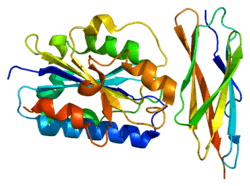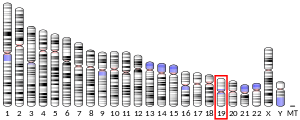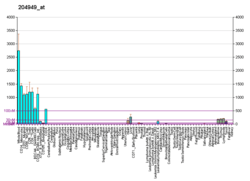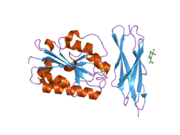ICAM3
Intercellular adhesion molecule 3 (ICAM3) also known as CD50 (Cluster of Differentiation 50), is a protein that in humans is encoded by the ICAM3 gene.
| ICAM3 | |||||||||||||||||||||||||
|---|---|---|---|---|---|---|---|---|---|---|---|---|---|---|---|---|---|---|---|---|---|---|---|---|---|
 | |||||||||||||||||||||||||
| |||||||||||||||||||||||||
| Identifiers | |||||||||||||||||||||||||
| Aliases | ICAM3, CD50, CDW50, ICAM-R, intercellular adhesion molecule 3 | ||||||||||||||||||||||||
| External IDs | OMIM: 146631 HomoloGene: 88479 GeneCards: ICAM3 | ||||||||||||||||||||||||
| |||||||||||||||||||||||||
| |||||||||||||||||||||||||
| |||||||||||||||||||||||||
| Orthologs | |||||||||||||||||||||||||
| Species | Human | Mouse | |||||||||||||||||||||||
| Entrez |
| ||||||||||||||||||||||||
| Ensembl |
| ||||||||||||||||||||||||
| UniProt |
| ||||||||||||||||||||||||
| RefSeq (mRNA) |
| ||||||||||||||||||||||||
| RefSeq (protein) |
| ||||||||||||||||||||||||
| Location (UCSC) | Chr 19: 10.33 – 10.34 Mb | n/a | |||||||||||||||||||||||
| PubMed search | [2] | n/a | |||||||||||||||||||||||
| Wikidata | |||||||||||||||||||||||||
| |||||||||||||||||||||||||
Function
The protein encoded by this gene is a member of the intercellular adhesion molecule (ICAM) family. All ICAM proteins are type I transmembrane glycoproteins, contain 2-9 immunoglobulin-like C2-type domains, and bind to the leukocyte adhesion LFA-1 protein. This protein is constitutively and abundantly expressed by all leukocytes and may be the most important ligand for LFA-1 in the initiation of the immune response.[3] It functions not only as an adhesion molecule, but also as a potent signalling molecule.[4]
Interactions
ICAM3 has been shown to interact with EZR[5][6] and Moesin.[6][7]
See also
References
- GRCh38: Ensembl release 89: ENSG00000076662 - Ensembl, May 2017
- "Human PubMed Reference:". National Center for Biotechnology Information, U.S. National Library of Medicine.
- de Fougerolles AR, Springer TA (Jan 1992). "Intercellular adhesion molecule 3, a third adhesion counter-receptor for lymphocyte function-associated molecule 1 on resting lymphocytes". The Journal of Experimental Medicine. 175 (1): 185–90. doi:10.1084/jem.175.1.185. PMC 2119096. PMID 1730916.
- "Entrez Gene: ICAM3 intercellular adhesion molecule 3".
- Heiska L, Alfthan K, Grönholm M, Vilja P, Vaheri A, Carpén O (Aug 1998). "Association of ezrin with intercellular adhesion molecule-1 and -2 (ICAM-1 and ICAM-2). Regulation by phosphatidylinositol 4, 5-bisphosphate". The Journal of Biological Chemistry. 273 (34): 21893–900. doi:10.1074/jbc.273.34.21893. PMID 9705328.
- Serrador JM, Vicente-Manzanares M, Calvo J, Barreiro O, Montoya MC, Schwartz-Albiez R, Furthmayr H, Lozano F, Sánchez-Madrid F (Mar 2002). "A novel serine-rich motif in the intercellular adhesion molecule 3 is critical for its ezrin/radixin/moesin-directed subcellular targeting". The Journal of Biological Chemistry. 277 (12): 10400–9. doi:10.1074/jbc.M110694200. PMID 11784723.
- Serrador JM, Alonso-Lebrero JL, del Pozo MA, Furthmayr H, Schwartz-Albiez R, Calvo J, Lozano F, Sánchez-Madrid F (Sep 1997). "Moesin interacts with the cytoplasmic region of intercellular adhesion molecule-3 and is redistributed to the uropod of T lymphocytes during cell polarization" (PDF). The Journal of Cell Biology. 138 (6): 1409–23. doi:10.1083/jcb.138.6.1409. PMC 2132557. PMID 9298994.
Further reading
- Simmons DL (1995). "The role of ICAM expression in immunity and disease". Cancer Surveys. 24: 141–55. PMID 7553659.
- Hayflick JS, Kilgannon P, Gallatin WM (1998). "The intercellular adhesion molecule (ICAM) family of proteins. New members and novel functions". Immunologic Research. 17 (3): 313–27. doi:10.1007/BF02786454. PMID 9638475.
- Fawcett J, Holness CL, Needham LA, Turley H, Gatter KC, Mason DY, Simmons DL (Dec 1992). "Molecular cloning of ICAM-3, a third ligand for LFA-1, constitutively expressed on resting leukocytes". Nature. 360 (6403): 481–4. doi:10.1038/360481a0. PMID 1448173.
- Vazeux R, Hoffman PA, Tomita JK, Dickinson ES, Jasman RL, St John T, Gallatin WM (Dec 1992). "Cloning and characterization of a new intercellular adhesion molecule ICAM-R". Nature. 360 (6403): 485–8. doi:10.1038/360485a0. PMID 1448174.
- Pino-Otín MR, Juan M, de la Fuente MA, Viñas O, Martínez-Cáceres E, Fernández MD, Miralles A, Vilella R, Yagüe J, Vives J (Jul 1995). "CD50 (intercellular adhesion molecule-3) is expressed at higher levels on memory than on naive human T cells but induces a similar calcium mobilization on both subsets". Tissue Antigens. 46 (1): 32–44. doi:10.1111/j.1399-0039.1995.tb02473.x. PMID 7482494.
- Marazuela M, Postigo AA, Acevedo A, Díaz-González F, Sanchez-Madrid F, de Landázuri MO (Oct 1994). "Adhesion molecules from the LFA-1/ICAM-1,3 and VLA-4/VCAM-1 pathways on T lymphocytes and vascular endothelium in Graves' and Hashimoto's thyroid glands". European Journal of Immunology. 24 (10): 2483–90. doi:10.1002/eji.1830241034. PMID 7523142.
- Holness CL, Bates PA, Little AJ, Buckley CD, McDowall A, Bossy D, Hogg N, Simmons DL (Jan 1995). "Analysis of the binding site on intercellular adhesion molecule 3 for the leukocyte integrin lymphocyte function-associated antigen 1". The Journal of Biological Chemistry. 270 (2): 877–84. doi:10.1074/jbc.270.2.877. PMID 7822326.
- Martin S, Rieckmann P, Melchers I, Wagner R, Bertrams J, Voskuyl AE, Roep BO, Zielasek J, Heidenthal E, Weichselbraun I (Feb 1995). "Circulating forms of ICAM-3 (cICAM-3). Elevated levels in autoimmune diseases and lack of association with cICAM-1". Journal of Immunology. 154 (4): 1951–5. PMID 7836774.
- Bossy D, Mattei MG, Simmons DL (Oct 1994). "The human intercellular adhesion molecule 3 (ICAM3) gene is located in the 19p13.2-p13.3 region, close to the ICAM1 gene". Genomics. 23 (3): 712–3. doi:10.1006/geno.1994.1565. PMID 7851905.
- Skubitz KM, Ahmed K, Campbell KD, Skubitz AP (Mar 1995). "CD50 (ICAM-3) is phosphorylated on tyrosine and is associated with tyrosine kinase activity in human neutrophils". Journal of Immunology. 154 (6): 2888–95. PMID 7876557.
- Maruyama K, Sugano S (Jan 1994). "Oligo-capping: a simple method to replace the cap structure of eukaryotic mRNAs with oligoribonucleotides". Gene. 138 (1–2): 171–4. doi:10.1016/0378-1119(94)90802-8. PMID 8125298.
- Juan M, Vilella R, Mila J, Yagüe J, Miralles A, Campbell KS, Friedrich RJ, Cambier J, Vives J, De Fougerolles AR (Jul 1993). "CDw50 and ICAM-3: two names for the same molecule". European Journal of Immunology. 23 (7): 1508–12. doi:10.1002/eji.1830230717. PMID 8325327.
- de Fougerolles AR, Klickstein LB, Springer TA (Apr 1993). "Cloning and expression of intercellular adhesion molecule 3 reveals strong homology to other immunoglobulin family counter-receptors for lymphocyte function-associated antigen 1". The Journal of Experimental Medicine. 177 (4): 1187–92. doi:10.1084/jem.177.4.1187. PMC 2190956. PMID 8459213.
- Hosaka S, Shah MR, Pope RM, Koch AE (Mar 1996). "Soluble forms of P-selectin and intercellular adhesion molecule-3 in synovial fluids". Clinical Immunology and Immunopathology. 78 (3): 276–82. doi:10.1006/clin.1996.0039. PMID 8605703.
- Van der Vieren M, Le Trong H, Wood CL, Moore PF, St John T, Staunton DE, Gallatin WM (Dec 1995). "A novel leukointegrin, alpha d beta 2, binds preferentially to ICAM-3". Immunity. 3 (6): 683–90. doi:10.1016/1074-7613(95)90058-6. PMID 8777714.
- Hayflick JS, Stine J, Fox R, Hoekstra D, Gallatin WM (Aug 1997). "Functional mapping of the cytoplasmic region of intercellular adhesion molecule-3 reveals important roles for serine residues". The Journal of Biological Chemistry. 272 (35): 22207–14. doi:10.1074/jbc.272.35.22207. PMID 9268366.
- Serrador JM, Alonso-Lebrero JL, del Pozo MA, Furthmayr H, Schwartz-Albiez R, Calvo J, Lozano F, Sánchez-Madrid F (Sep 1997). "Moesin interacts with the cytoplasmic region of intercellular adhesion molecule-3 and is redistributed to the uropod of T lymphocytes during cell polarization" (PDF). The Journal of Cell Biology. 138 (6): 1409–23. doi:10.1083/jcb.138.6.1409. PMC 2132557. PMID 9298994.
- Suzuki Y, Yoshitomo-Nakagawa K, Maruyama K, Suyama A, Sugano S (Oct 1997). "Construction and characterization of a full length-enriched and a 5'-end-enriched cDNA library". Gene. 200 (1–2): 149–56. doi:10.1016/S0378-1119(97)00411-3. PMID 9373149.
- Bernstein CN, Sargent M, Gallatin WM (Feb 1998). "Beta2 integrin/ICAM expression in Crohn's disease". Clinical Immunology and Immunopathology. 86 (2): 147–60. doi:10.1006/clin.1997.4462. PMID 9473377.
External links
- ICAM3+protein,+human at the US National Library of Medicine Medical Subject Headings (MeSH)
This article incorporates text from the United States National Library of Medicine, which is in the public domain.



